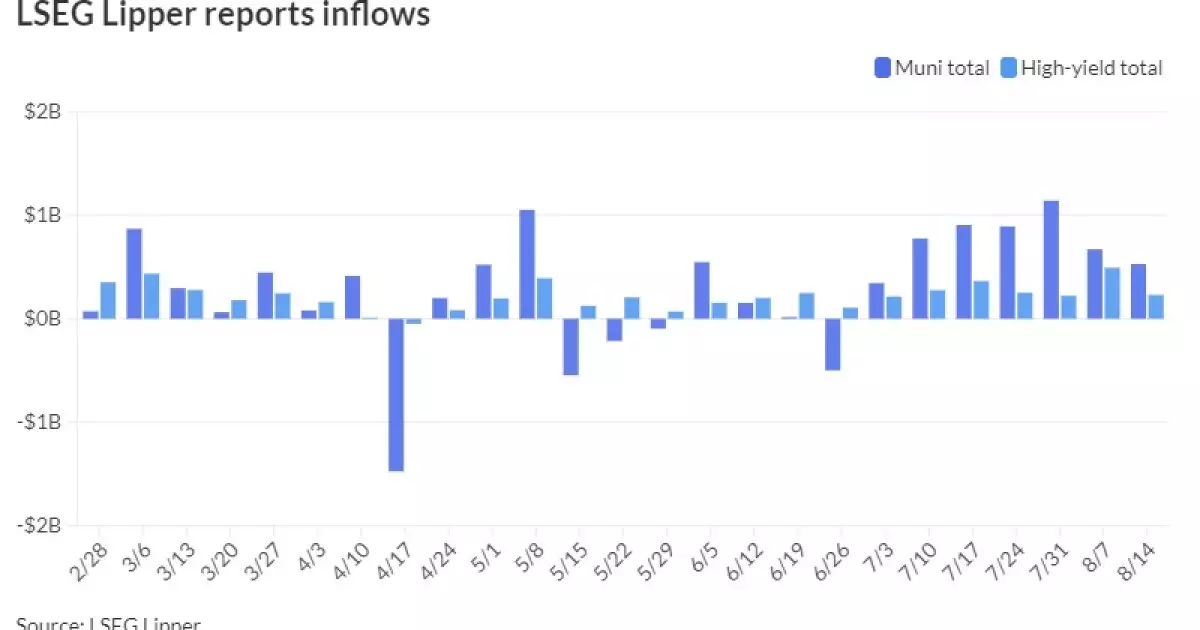The recent U.S. Treasury market selloff had a significant impact on the municipal bond market. However, despite the pressure felt by municipals, they outperformed their taxable counterparts. This can be attributed to better economic data, which led investors to shift towards equities in a risk-on trade. As a result, Triple-A yields rose slightly, varying between two to four basis points, depending on the yield curve. On the other hand, U.S. Treasuries saw losses of up to 15 basis points on the short end, causing municipal to UST ratios to decrease. This shift in ratios indicates changes in investor sentiment and risk perception.
Following the day’s market movements, muni-to-UST ratios were lower across different maturities. According to Refinitiv Municipal Market Data and ICE Data Services, the ratios were as follows: two-year at 64%/66%, three-year at 66%/68%, five-year at 67%/68%, 10-year at 69%/70%, and 30-year at 86%/85% respectively. Despite the market fluctuations, municipal bond mutual funds continued to see inflows, with investors adding significant amounts. There were $528.7 million of inflows reported after $674.1 million the week before. This trend signifies ongoing investor interest and confidence in municipal bonds as a stable investment option.
Primary Market Pricing and Upsizing
In the primary market, the final large deals of the week were priced and in some cases, upsized to meet demand. Notable deals included the Triborough Bridge and Tunnel Authority bonds, NJ Health Care Facilities Financing Authority bonds, and Reno-Tahoe Airport Authority bonds. These deals were well received by investors, reflecting the strong demand for municipal bonds amidst market uncertainties. The pricing and upsizing of these deals indicate a positive outlook for the municipal bond market, despite the broader economic challenges.
Visible Supply Growth and Reinvestment Cash
The Bond Buyer 30-day visible supply grew to $17.64 billion as investors began to digest substantial reinvestment cash hitting the market. Approximately $15 to $20 billion of reinvestment cash was expected to boost demand, especially in the 1-10 year portion of the market. J.P. Morgan strategists predicted increased demand in this sector due to limited support earlier in the week. They also noted that the reinvestment credits being issued were essential for market liquidity and investor participation. The correlation between reinvestment cash and market performance highlights the interconnectedness of factors influencing municipal bond dynamics.
The interest rate trends in the municipal bond market have been shifting gradually over the past month. Short yields have aligned more closely with the 10-year range, resulting in a narrower gap between 1- and 5-year bonds. This adjustment signifies a flattening yield curve and changing investor preferences for certain maturities. Additionally, the upcoming new-issue calendar offers long-dated maturities, presenting opportunities for investors seeking stable returns over a longer horizon. Analysts anticipate continued bond-buying opportunities in the fall, driven by market technicals and investor sentiment surrounding the upcoming election.
The impact of the U.S. Treasury market selloff on municipal bonds reflects the dynamic nature of fixed-income markets. Despite market fluctuations and changing investor behavior, municipals have shown resilience and relative outperformance compared to other asset classes. The trends in market ratios, inflows, primary market activity, visible supply growth, and interest rate dynamics paint a complex picture of market sentiment and performance. Investors and market participants must closely monitor these trends to make informed decisions and navigate the evolving landscape of municipal bond investing.

